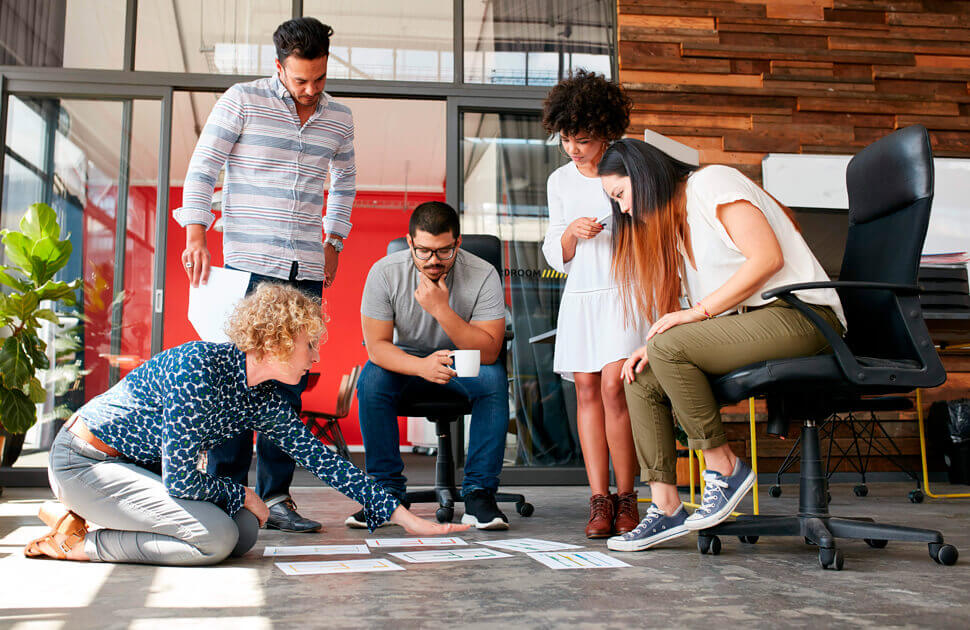In recent years, there have been some fundamental changes in the office, and the conventional model of workplace seems to be obsolete. Traditionally, each employee was expected to enter the office and sit at his desk, working from 9 to 5 (or more). In today’s world, driven by technology, employees have more flexible work schedules and can telecommute from anywhere: from a sofa in the office, from the kitchen in your home, to a coffee shop or even on the beach.
And surprisingly (or maybe not), productivity has never been so high. It is less about where the work is done and more about how the work is done. And in an era where workplace culture is more important than ever, the functionality and design of the office can have a big impact on productivity, as well as employee acquisition and retention.
Challenges And Trends For Modern Office Spaces
There are many new trends and challenges at play in the modern workplace, forcing companies to adapt or be left behind. What characteristics and how will the workplace of the future be?
1) A Multigenerational Workplace
Now there are up to five generations in the workplace. As people live longer, their life expectancy also expands, which in turn extends the overlap between generations. Although this situation presents the opportunity for people to grow and learn from each other, it also presents a challenge, since each of these generations uses different styles of work, communication and collaboration.
2) Increase In Teleworking
A Gallup poll conducted in 2017 found that more and more US employees work remotely and for longer periods of time, and more than 40% of workers spend at least part of the time working remotely. Now, an increasing number of job seekers take into account flexible scheduling and work-from-home opportunities when deciding to take or even quit a job. And working outside the conventional site has become a kind of amenity and a key business strategy.
3) Greater Collaboration
As companies break organizational silos and become more aligned, members of their team increasingly collaborate with others beyond their own department. This new work model requires a more flexible space that allows both team time and individual time.
What Are The Main Challenges That Organizations Face In The Design Of Modern Office Spaces?
1) Open Offices, 3.0
Traditional designs included private offices for executives outside the office and cubicles for lower-level employees crowded in the center, generally promoting a hierarchical workflow. Subsequently, the offices presented large open spaces and minimized the presence of small and closed rooms, such as private offices. Four out of five offices now have an open floor plan, hoping to inject more creativity, communication and collaboration and mimic the appearance of “new businesses.” Currently, spaces have been created for specific activities such as seats for small group meetings, open areas for hanging out (such as in the rest room) and closed spaces for quiet or private tasks. This format adapts to different work styles and diverse needs of employees.
2) Demand For More Amenities
In the war for talent, companies are offering more and more services to make life easier for their employees increase productivity and reduce stress. According to a 2018 report by HQO, physical condition and diet are the two most requested office services. The most modern offices offer healthy meals and coffees. In addition, they have gyms so that employees can exercise before or after work. Similarly, standing desks lift employees from their seats. In addition, libraries and classrooms offer employees a space where they can take a break or relax without having to leave the office.
3) Increase Of The Smart Office
Technology is changing the way people live, work and play, and at this time it affects almost every aspect of our lives. An office with technology enabled allows employees to work smarter and faster, boosting productivity and final results. Technology needs include computer and software upgrades, smart cards, wireless charging ports, a good WiFi signal and even virtual reality systems. Even features such as intelligent lighting, climate control and air quality control can have a great impact on alleviating common office problems.
4) The offices turn green … literally
Most employees spend more consecutive hours of work in the office than anywhere else, including their own home. And due to many factors, from the location of the office to having a full schedule, many people are challenged to find time to get out. Then, why not bring the outside inside? Studies have shown that having natural light and plants inside the office, from green walls and living trees to potted plants and bamboo walls, can increase productivity by up to 15%.
In conclusion, the workplace of the future requires a change of entrenched beliefs about what an office should look like. While it can be a fluid process of change and improvement, the modern workspace plays and will continue to play a key role in the productivity of the organization, the culture of the company and the acquisition and retention of employees.
 Subscribe
Subscribe
 Ask for a demo
Ask for a demo

 4 min
4 min
